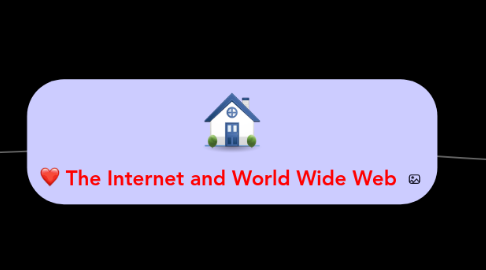
1. The Internet
1.1. The Internet
1.1.1. a worldwide collection of networks that links millions of
1.1.1.1. Businesses
1.1.1.2. Government agencies
1.1.1.3. educational institutions
1.1.1.4. individuals
1.2. Evolution of the Internet
1.2.1. The Internet originated as ARPANET in September 1969 and had two main goals
1.2.1.1. o 1969 ARPANET becomes functional
1.2.1.2. o 1984 ARPANET has more than 1000 individual computers linked as hosts
1.2.1.3. o 1986 NSF connects NSFnet to ARPANET and becomes known as the Internet
1.2.1.4. o 1995 NSFNet terminates its network on the Internet and resumes status as research network
1.2.1.5. o 1996 Internet2 is founded
1.2.1.6. o Today More than 550 million hosts connect to the Internet
1.2.2. Each organization is responsible only for maintaining its own network
1.2.3. Internet2 connects more than 200 universities and 115 companies via a high‐speed private network
1.2.4. Many home and small business users connect to the Internet via high‐speed broadband Internet service
1.2.4.1. o Cable Internet service
1.2.4.2. o DLS
1.2.4.3. o Fiber to the Premises (FTTP)
1.2.4.4. o Fixed wireless
1.2.4.5. o Cellular Radio Network
1.2.4.6. o Wi-Fi
1.2.4.7. o Satellite Internet Service
1.2.5. An access provider
1.2.5.1. a business that provides individuals and organizations access to the Internet free or for a fee
1.2.5.1.1. o ISP (Internet service provider)
1.2.5.1.2. o Online service provider (OSP)
1.2.5.1.3. o Wireless Internet service provider (WISP)
1.2.6. IP address
1.2.7. A domain name
1.2.7.1. a number that uniquely identifies each computer or device connected to the Internet
1.2.7.2. the text version of an IP address
1.2.7.2.1. o Top‐level domain (TLD)
1.2.8. A DNS server translates the domain name into its associated IP address
1.3. Other Internet Services
1.3.1. E‐mail
1.3.1.1. the transmission of messages and files via a computer network
1.3.2. e‐mail program
1.3.2.1. allows you to create, send, receive, forward, store, print, and delete e‐mail messages
1.3.3. mailing list
1.3.3.1. a group of e‐mail names and addresses given a single name
1.3.3.2. Subscribing
1.3.3.2.1. adds your e‐mail name and address
1.3.3.3. Unsubscribing
1.3.3.3.1. removes your name
1.3.4. Instant messaging (IM)
1.3.4.1. a real‐time Internet communications service
1.3.5. chat
1.3.5.1. a real‐time typed conversation that takes place on a computer
1.3.6. chat room
1.3.6.1. a location on an Internet server that permits users to chat with each other
1.3.7. VoIP (Voice over IP)
1.3.7.1. an online area in which users have written discussions about a particular subject
1.3.7.2. Typically requires a newsreader
1.3.8. message board
1.3.8.1. a Web‐based type of discussion group
1.3.9. FTP (File Transfer Protocol)
1.3.9.1. an Internet standard that permits file uploading and downloading with other computers on the Internet
1.3.9.2. Many operating systems include FTP capabilities
2. The World Wide Web
2.1. The World Wide Web
2.1.1. The World Wide Web, or Web, consists of a worldwide collection of electronic documents (Web pages)
2.1.2. Web site
2.1.2.1. a collection of related Web pages and associated items
2.1.3. Web server
2.1.3.1. a computer that delivers requested Web pages to your computer
2.1.4. Web 2.0 refers to Web sites that provide a means for users to interact
2.1.5. Web browser
2.1.5.1. o Internet Explorer
2.1.5.2. o Firefox
2.1.5.3. o Opera
2.1.5.4. o Safari
2.1.5.5. o Google Chrome
2.1.6. Home page
2.1.6.1. the first page that a Web site displays
2.1.7. Some Web pages are designed specifically for microbrowsers
2.1.8. Web pages provide links to other related Web pages
2.1.8.1. o Surfing the Web
2.1.9. Downloading
2.1.9.1. the process of receiving information
2.1.10. A Web page has a unique address called a URL or Web address
2.1.11. Tabbed browsing allows you to open and view multiple Web pages in a single Web browser window
2.1.12. Two types of search tools
2.1.12.1. search engine
2.1.12.1.1. Finds information related to a specific topic
2.1.12.1.2. A search engine is helpful in locating items such as
2.1.12.2. subject directories
2.1.12.2.1. Classifies Web pages in an organized set of categories
2.1.13. Multimedia refers to any application that combines text with
2.1.13.1. o Graphic
2.1.13.2. o Animation
2.1.13.3. o Audio
2.1.13.3.1. You listen to audio on your computer using a player
2.1.13.4. o Streaming
2.1.13.5. o Video
2.1.13.6. o Virtual reality (VR)
2.1.13.7. o Plug‐in
2.1.13.8. o Web publishing
2.1.13.8.1. Plan a Web Site
2.1.13.8.2. Analyze and design a Web site
2.1.13.8.3. Create a Web site
2.1.13.8.4. Deploy Web site
2.1.13.8.5. Maintain a Web site
2.2. E‐Commerce
2.2.1. a business transaction that occurs over an electronic network
2.2.1.1. o Business to consumer (B2C)
2.2.1.2. o Business to business (B2B)
2.2.1.3. o Consumer to consumer (C2C)
2.3. Netiquette
2.3.1. the code of acceptable Internet Behavior
2.4. Summary
2.4.1. History and structure of the Internet
2.4.2. World Wide Web
2.4.3. Browsing navigating,searching, Web publishing, and e‐commerce
2.4.4. Other Internet services:e‐mail, instant messaging, chat rooms,VoIP newsgroups and message boards, and FTP
2.4.5. Rules of netiquette
